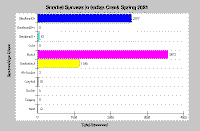Bibliography Background About KRIS
Hypothesis #1: The distribution and abundance of coho salmon in the Navarro River basin have diminished over recent decades.
It is likely that coho salmon have suffered several periods of decline in the Navarro, but scientific evidence can only substantiate the decline in abundance and distribution after 1945. California Department of Fish and Game (CDFG) memos and fish samples from 1945-1970 chronicle the complete destruction of streams that formerly harbored coho. CDFG downstream migrant trapping samples in 1972 and 1996 showed further decline of the species. Recent studies by the University of California (U.C.) Davis found that the range of coho diminished between the late 1980's to 2001 (Johnson et al., 2002).
While the Navarro River was famous for its salmon and steelhead fishing, there is no baseline information on populations of coho salmon. The first wave of logging in the Navarro River occurred in the late 1800's and early 1900's and was focused on the lower mainstem and North Fork. It included at least limited use of splash dams, which would have been highly destructive to stream channels. Although this intensive land use undoubtedly compromised salmon production, coho salmon still found intact habitat in steep, inaccessible watersheds not impacted by the first wave of logging.
Rancheria Creek resident Maurice Tindall (1978) documented large numbers of coho salmon spawning throughout the Navarro River basin in his book Down to Earth: A Mendocino County Life.
"In the years before after 1910 we seemed to have a better flow of water especially on the Navarro River watershed. That would include Anderson Creek past Boonville and Indian and Coon Creeks down the Valley. There were salmon runs out past Yorkville and no doubt in many of the smaller branches when there was enough water at the right time."
"The water would rise enough so that the hookbills could come up and be spawning by December 10th to the 20th or even a little later after the Holidays....After the river highway was opened up in 1925 it was lots easier to get to the coast... and we could catch the hookbills down at the mouth of the river by trolling."
"Through many persistently bad years with low rainfall in the 1920's the hookbill run slowed down greatly and fishing wasn't so good but by early in the 1930's the rainfall improved and again we had big runs of silver salmon."
Leo Shapovalov (California Bureau of Fish Conservation, 1948) described coho salmon juveniles in Indian Creek upstream of the West Fork in August 1948: "Spawning areas and pools and shelter are good in the vicinity of the Peachland Road crossing. Steelhead 2 to 3" long were abundant, and a few 5" long were seen. Silver salmon 3 1/2 to 4" long were common. Bottom foods were abundant."
Damage to coho salmon habitat in the Navarro River basin is extensively chronicled in California Department of Fish and Game memos following post World War II logging (CDFG, 1955; 1962a; 1962b). Figure 1 shows Ham Canyon Creek, a former coho salmon producing tributary of Rancheria Creek, after stream habitat was so degraded that coho could no longer be supported.
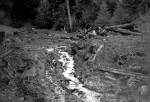 This California Department of Fish and Game photo from 1963 shows the extent of logging damage to Ham Canyon Creek – no riparian vegetation and no defined channel. The destructive impacts of logging damaged this reach to such an extent that it is no longer coho salmon habitat.
This California Department of Fish and Game photo from 1963 shows the extent of logging damage to Ham Canyon Creek – no riparian vegetation and no defined channel. The destructive impacts of logging damaged this reach to such an extent that it is no longer coho salmon habitat.
CDFG (1962a) described the damage as follows: “Ham Canyon Creek has received extensive damage by past and recent logging. Flow is intermittent in many places. Ham Canyon Creek is practically useless at this time to anadromous fish due to the heavy damage received.” Similar damage was described in Dago Creek, another Rancheria Creek tributary (CDFG, 1962b): “The extensive logging damage in recent and past years has rendered this stream almost useless to anadromous fish life. The main Dago Creek from the road crossing upstream up to the landing/turn around, approximately 1.9 miles, is a continuous log jam, heavily silted-in area. Landing and clearings have been created at many places throughout the stream as well as all tributary confluences. The amount of material stacked up is fabulous. The main creek is no longer. It is just a wide path used by logging trucks and skid trails by tractors.”
The California Department of Fish and Game (1955) netted of over 50,000 juvenile coho in Rancheria Creek while conducting fish rescue operations for juvenile salmonids stranded in side channels (Figure 2). Brown (1972) caught coho juveniles in a downstream migrant trap in Rancheria Creek at Fish Rock Road in only one night of sampling. He also trapped on several nights at Dimmick State Park on the lower Navarro River in April and May 1972. These samples had more coho juveniles than steelhead, which contrasts with CDFG downstream migrant trap results from the same location in 1996 (Figure 4). Steelhead were far more numerous than coho in 1996 and fewer coho were caught in most weeks than were caught by Brown (1972) each night in 1972.
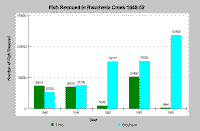 Figure 2. This chart shows fish rescue efforts in Rancheria Creek during the years 1948 through 1952. Fish were rescued during summer months. The side channels were caused by massive bedload build up from logging in tributaries. No other surveys have documented such large coho populations anywhere else in the Navarro basin. Data from the California Department of Fish and Game (1955).
Figure 2. This chart shows fish rescue efforts in Rancheria Creek during the years 1948 through 1952. Fish were rescued during summer months. The side channels were caused by massive bedload build up from logging in tributaries. No other surveys have documented such large coho populations anywhere else in the Navarro basin. Data from the California Department of Fish and Game (1955).
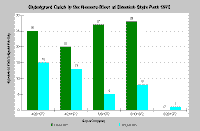 Figure 3. Coho and steelhead fry were caught in a downstream migrant trap in the Navarro River at Dimmick State Park. Note that coho were more numerous in samples than steelhead. Data were collected on five nights during April and May 1972 using a fyke net. Data provided by California Department of Fish and Game (Brown, 1972).
Figure 3. Coho and steelhead fry were caught in a downstream migrant trap in the Navarro River at Dimmick State Park. Note that coho were more numerous in samples than steelhead. Data were collected on five nights during April and May 1972 using a fyke net. Data provided by California Department of Fish and Game (Brown, 1972).
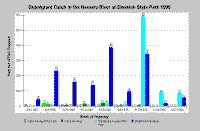 Figure 4. More steelhead juveniles than coho were caught by CDFG in a downstream migrant trap operated in the Navarro River at Dimmick State Park in 1996, as displayed on this chart. These weekly totals and show extremely low numbers of coho in the Navarro River. Data provided by California Department of Fish and Game.
Figure 4. More steelhead juveniles than coho were caught by CDFG in a downstream migrant trap operated in the Navarro River at Dimmick State Park in 1996, as displayed on this chart. These weekly totals and show extremely low numbers of coho in the Navarro River. Data provided by California Department of Fish and Game.
From 1999-2001, the University of California at Davis studied the Navarro River and its coho salmon and steelhead populations (Johnson et al., 2002). Extensive dive surveys showed that the fish communities in streams that formerly harbored coho salmon no longer had them. Observations in former coho streams like Indian Creek (Figure 5) and Rancheria Creek (Figure 6) were dominated by the warm-water-adapted California roach. The U.C. Davis team (Johnson et al., 2002) supplemented their own dive survey information with that of CDFG and made the following estimate of the decrease in coho range in the Navarro River basin: "Using Geographic Information Systems, we identified a 78.4 percent reduction in the linear distribution of coho salmon from their historic watershed distribution over the last 12 years."
Figure 5. This chart displays snorkel data from surveys in Indian Creek in spring, 2001. Surveys were done in lower, middle and upper Indian Creek. They show a community structure dominated by California roach, but with a substantial component of steelhead and threespine stickleback. Coho were not found in any of the three reaches, confirming a decrease in the historic range of coho. Data provided by University of California, Davis.
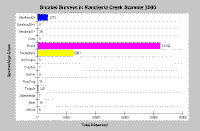 Figure 6. This chart displays snorkel data from surveys in Rancheria Creek in summer, 2000. Surveys were done in lower, middle and upper Rancheria Creek. They show a community structure dominated by California roach, threespine stickleback, and steelhead. Coho were absent in all reaches in Rancheria Creek as well, indicating a decrease in their former range. Data provided by University of California, Davis.
Figure 6. This chart displays snorkel data from surveys in Rancheria Creek in summer, 2000. Surveys were done in lower, middle and upper Rancheria Creek. They show a community structure dominated by California roach, threespine stickleback, and steelhead. Coho were absent in all reaches in Rancheria Creek as well, indicating a decrease in their former range. Data provided by University of California, Davis.
Regional documents on the status of coho have also chronicled their decline in the Navarro (Brown et al. (1994; CDFG, 2002). Brown et al. (1994) found that coho were absent from 21% of the Navarro River tributaries in which they were formerly present, based on a partial survey of the basin. The Status review of California coho salmon north of San Francisco: Report to the California Fish and Game Commission (CDFG, 2002) noted that coho remained only in the western part of the Navarro River basin, mostly in the North Fork.
Topics Supporting the Hypotheses
The following is a list of Topics in KRIS Navarro where you can see data in its context, Metadata and associated Info Links. The large-case letters in parentheses indicate KRIS sub-basins.
(RC) Tour: 2. Historic Photos, Ham Canyon Cr Log Jam Removal 1963
(MN) Fish: Dimmick State Park Trap, Out-migrant Catch Daily Totals, 1972
(MN) Fish: Fish: Dimmick State Park Trap, Out-migrant Catch Weekly Totals, 1996
(IC) Fish: Snorkel Surveys Indian Creek Spring 2001
(RC) Fish: Snorkel Surveys Rancheria Creek Summer 2000
Alternative Hypothesis
The observed change in the distribution and abundance of coho in the Navarro Basin is within the natural range of variability.
Ocean conditions and fishing are known to have caused variable ocean survival off the Pacific Northwest coast with attendant cycles in abundance for coho salmon (Finney et al., 2000). Given the lack of long term trend data for adult coho salmon, some contend that a decline in the species can not actually be established (Ellis, 1997).
Monitoring Trends to Test the Hypotheses
To see if salmon and steelhead populations are, indeed, just in natural remission and will rebound in the future, fish surveys like spawner and redd counts, creel census, downstream migrant trapping and more widespread electrofishing should be conducted throughout the Navarro River basin, particularly on tributaries east of the North Fork.
References
Brown, L.R., P.B. Moyle, and R.M. Yoshiyama. 1994. Historical Decline and Current Status of Coho Salmon in California. North American Journal of Fisheries Management. 14(2):237-261. (Coho salmon were not found in 21% of their former range in the Navarro River watershed between the early 1980s and 1991, with an estimated population of 300 adults. The authors suggest that a minimum of 100 fish are necessary to preserve genetic integrity.
Brown, C. J. 1972. Downstream migration of salmonids in the Navarro River, April through June 1972. California Department of Fish and Game. Bay-Delta and Special Water Projects Division . Yountville, CA. 8 pp. [24kb]**)
California Bureau of Fish Conservation. 1948. Indian Creek (Navarro River tributary) field note, dated 18 August 1948 . Unpublished file memo by L. Shapovalov. Yountville, CA. 2 pp. [7kb]**
California Department of Fish and Game. 1955. Recommendation for the Development of the Navarro River Basin to Benefit Anadromous Fishes. Correspondence by Leonard O. Fisk to Willis Evans, CDFG, January 27, 1955.
California Department of Fish and Game (CDFG). 1962. Ham Canyon Creek (Rancheria Creek tributary) stream survey, 17 September 1962 . CDFG unpublished file memo by S.N. Nye, with Redwood Creek supplemental from 20 June 1959 file memo by G. Holman. Yountville, CA . 5 pp. [458kb]
California Department of Fish and Game (CDFG). 1962. Rancheria Creek (Navarro River tributary) stream survey, 30 August through 7 September 1962 . CDFG unpublished file memo by R. Moore. Yountville, CA. 10 pp. [82kb] **
California Department of Fish and Game (CDFG). 1962. Dago Creek (Rancheria Creek tributary) stream survey, 18/19 September 1962 . CDFG unpublished file memo by S.N. Nye. Yountville, CA . 5 pp. [1.31Mb]**
California Department of Fish and Game (CDFG). 2002. Status review of California coho salmon north of San Francisco: Report to the California Fish and Game Commission. CDFG. Sacramento, CA. 336 pp. [6.9Mb]
Ellis, R. H. 1997. Comments to National Marine Fisheries Service regarding the proposed listing of coho salmon as threatened in the Southern Oregon/Northern California ESU. Submitted on behalf of: California Forestry Association and California Forest Resources Council, Sacramento, CA. 41 p.
Finney, B.P., I. Gregory-Evans, J. Sweetman, M.S. Douglas, J.P. Smol. 2000. Impacts of Climatic Change and Fishing on Pacific Salmon Abundance Over the Past 300 Years. Science. 2000, Oct 27; 290 (5492):795-799.
Johnson, M. L., G. Pasternack, J. Florsheim, I. Werner, T. B. Smith, L. Bowen, M. Turner, J. Viers, J. Steinmetz, J. Constatine, E. Huber, O. Jorda, and J. Feliciano. 2002. North coast river loading study: Road crossing on small streams. Volume I. Status of salmonids in the watershed. Prepared for the Division of Environmental Analysis, California Department of Transportation. John Muir Institute of the Environment. University of California . Davis, CA . 108 pp. [2.4Mb]
Tindall, M.W. 1978. Down to Earth: A Mendocino County Life. Pacific Rim Research. Mendocino, CA. 191 pp.
